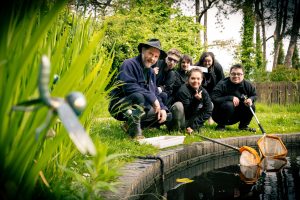Council is urging the public to be cautious when visiting beaches and rivers in the Causeway Coast and Glens area, due to the potential presence of blue-green algae.
Blue-green algae has been travelling downstream from Lough Neagh throughout the summer, impacting facilities along the River Bann and coastal areas in the Borough. It is anticipated that more blooms will continue to arrive on our shores, subjected to weather and tidal conditions.
To help keep people safe from the effects of blue-green algae – which can be harmful to humans and potentially lethal to animals – Council is urging the public to heed the following safety advice.
If you suspect the presence of blue-green algae, please STAY OUT OF THE WATER AND KEEP YOUR PETS AWAY FROM THE WATER.
You should avoid water that:
- smells bad
- looks discoloured (often a pea green colour)
- has foam or scum on the surface
- has dead fish or other animals washed up on its shore
Not all blue-green algae blooms are toxic. However, you cannot tell if a bloom is toxic by looking at it, so it is best to assume it is harmful and take the following precautions:
- keep dogs on leads; do not allow dogs to drink from or swim in affected areas
- refrain from immersive activities including swimming and the launching of paddle boards, canoes, kayaks and personal watercraft
- do not swallow the water
- do not allow the algae to come into contact with your skin
- do not eat fish caught recreationally from the water
A Council spokesperson said: “Council wishes to advise all recreational users of beaches and rivers in the Borough to exercise caution and to follow the safety messaging.
“Council is working closely with DAERA, which is the lead Stormont Department for matters relating to Lough Neagh and is also responsible for bathing water quality testing. Our staff continue to monitor beaches and other sites for any visual presence of blue-green algae and we have erected warning signage at locations where we believe blue-green algae to be present.”
KEY FACTS
What does blue-green algae look like?
During a bloom, the water becomes less clear and may look green, blue-green or greenish-brown. Scums can form during calm weather when several bloom forming species rise to the surface. This can look like paint, mousse, or small clumps. The duration of blooms may last for a few days to several weeks until conditions in the water body change and the algae die and decompose.
What are the public health implications?
The excessive toxins produced during a bloom can potentially be harmful to public health. Blue-green algae can harm people, producing rashes after skin contact and illnesses if swallowed, or can potentially kill wild animals, livestock and pets if ingested. Algal blooms also block sunlight from reaching other plants in the water, use up oxygen in the water at night and when decaying and hence can suffocate fish and other creatures.
What to do if you spot blue-green algae
If you suspect that you have seen blue-green algae, please contact Northern Ireland Environment Agency, using their reporting app – Bloomin Algae App. You can also report through the NIEA incident hotline on 0800 80 70 60 or email emergency-pollution@daera-ni.gov.uk with a photo, if possible, and details on the location of the potential bloom.





